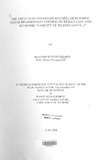| dc.description.abstract | The study was conducted to determine the effects of overnight housing,
supplementation, endo-parasite control and combinations of these husbandry practices
on the growth rate of weaner Galla goats in the southeastern rangelands of Kenya.
The study further sought to evaluate the economic viability of these husbandry
practices through a cost-benefit analysis. The experiment involved 40 weaner Galla
goats of similar age (7± 1 months) and weights (2l±3 kg) which were randomly
assigned to eight treatments of five weaners each. The treatments were housing (Tj),
supplementation (Ts), deworming (Ta), housing combined with supplementation (Ths),
housing combined with deworming (Thd), supplementation combined with deworming
(Tsd), housing combined with supplementation and deworming (Thsd) and a control
(Tc). Supplementation involved providing the goats with 100g of Acacia tortilis pods
per day at 08.00hrs, while deworming involved administration of a commercial
dewormer at the recommended dose at the beginning of the experiment and at three
month intervals thereafter. Housing involved sheltering the goats overnight to protect
them from cold and rain. The animals were weighed every week and weight gain
calculated as the difference between previous week's weight and the current week's
weight. The experiment lasted for 18 weeks. Overall, all the treatment groups
exhibited higher average weekly weight gains than the control throughout the trial
period. However, none of these accelerated growth rates was statistically significant
(P<0.05) for the first three weeks. From the fourth week, however, all the treatment
groups, except housing, had significantly (P<0.05) higher average growth rates than
the control group. Overall, Thsd exhibited the highest weight gain (6.95kg), followed
by Tsd (6.65kg). The cost-benefit analysis indicated that it is profitable for farmers to
supplement and/or deworm goats. The benefit-cost ratio (BCR) for the different
treatments showed that the most cost-effective treatment was deworming with a
benefit-cost ratio of 9.45. Supplementation and a combination of supplementation and
deworming were also cost-effective with a BCR of2.35 and 2.75 respectively, but at a
lower level. These results show that supplementing and/or deworming weaned goats
increases their growth rates. It is therefore recommended that farmers supplement
and/or deworm their animals to realize increased growth rates. | en |

